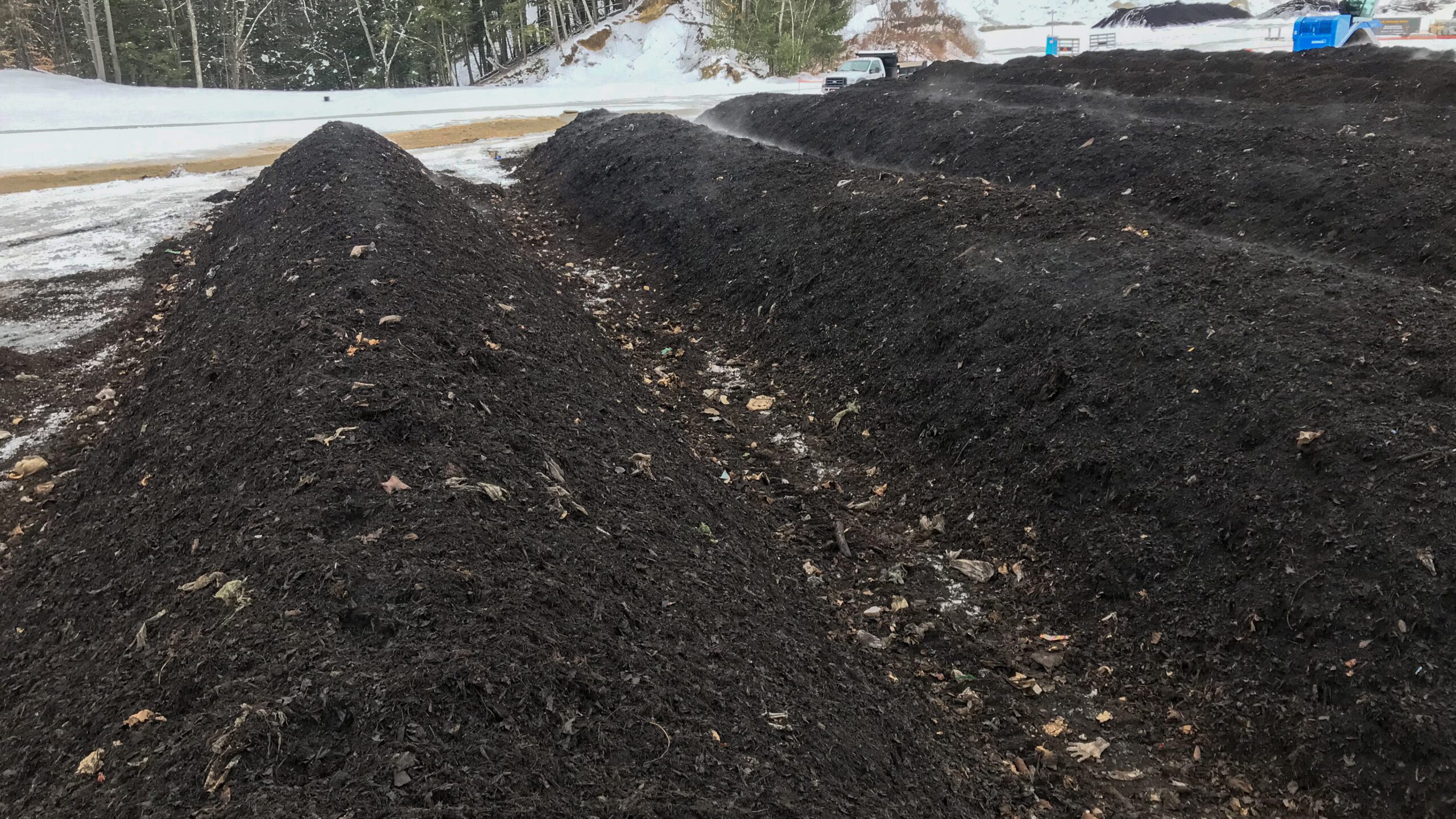All Drop-Off Centers, the Organics Recycling Facility, & the Environmental Depot will close at noon on Wed. 11/27 & all facilities are closed on Thurs. 11/28 for the holiday.
How We Make Compost

Science, systems, and a whole lot of microbial magic!
We make our compost using a process known as static aerated pile composting using local ingredients (what we call feedstocks) that would otherwise go to a landfill. We receive food scraps and leaves from local residents and area businesses.
These materials are mixed with wood chips, select local farm manures, and small amounts of wood ash to achieve a consistent and biodiverse recipe.
Micro-organisms, or microbes, are responsible for the seemingly magical process of composting. Microbes are already present in all of the feedstocks that come into GMC. Once mixed with the right ratio of nitrogen (“green” ingredients) and carbon (“brown” ingredients), plus the right amount of water and oxygen, the microbes really go nuts!
Moisture is essential for microbe movement and reproduction. Just like us, microbes also need oxygen. Without oxygen–like in a landfill, for example–the entire chemistry changes and composting comes to a stop. Our job is to create the perfect conditions for billions of microbes to do the job they are so good at doing—breaking down organic material into nutrient-rich compost.
Wicked good compost, in 7 steps
Step 1: Blending
We blend the proper ratio of ingredients with our giant windrow turner to achieve a carbon to nitrogen ratio of about 25 to 30 parts carbon to 1 part nitrogen (by weight), which is ideal for composting. Blending the feedstocks ensures a more uniform mix of all of these components, and a greater surface area for the microbes to nibble on, thus speeding up the composting process.
Nutrient-rich water from our underground storage tank is added to each batch to achieve an ideal 60% to 65% moisture.
Blended material is loaded into covered, concrete bays with perforated aeration pipes running along the bottom, and then capped with a layer of wood chips to trap odors and moisture.
Step 2: Aeration, Part I
(2 weeks)
Electric blowers push air through the perforated pipes and up through the piles, delivering oxygen to microbes and removing excess heat. As the pile temperature rises above 104°F, the microorganisms–mainly bacteria–found in this small ecosystem change from mesophilic to thermophilic (literally “heat-loving”). Thermophilic microbes break down sturdier materials like plant stems, leaves, and roots as well as animal proteins and fats.
We carefully monitor pile temperatures to ensure that all material meets a minimum of 131o F for at least three days—the state and federal standards. Weed seeds, jumping worms and their eggs and cocoons, and potentially harmful viruses, fungi, and bacteria cannot survive these high temperatures.
Temperature probes at different locations and depths on each pile send data to a computer or even our phones, enabling us to adjust the blowers to maintain ideal composting conditions at all times. Hotter is not necessarily better with composting. Pile temperatures tend to rise very quickly, often to well over 150o F in 24 hours within the first day or less, (even on Vermont’s coldest winter days!) We are careful to maintain the microbe “sweet spot” of 135-150 degrees.
After two weeks, we remove material from the phase 1 bunkers with a bucket loader and put it into a long pile–or windrow–on a central concrete pad. This ensures that the outside (less decomposed) part of the pile gets turned into the center for further decomposition by the thermophiles. Then we rewater the pile to bring it back up to 60-65% moisture.
Step 3: Aeration, Part II
(3 to 4 weeks)
The pile is then moved (and mixed again in process) to the uncovered side of the concrete pad for a second round of aeration.
We continue to monitor temperatures and oxygen to maintain optimum levels. Continued
thermophilic decomposition occurs in phase two, with temperatures averaging 135°F.
Step 4: Screening #1
We run each batch of compost through an industrial screening machine. This 2-inch screen removes large contaminants—things like utensils, plastic, rocks, and big chunks of wood, which are called “overs” and are sent to the landfill. Wood chips and other chunky organic materials are recycled back into future batches.
Step 5: Curing
(3-4 months)
Screened compost is hauled to a curing area where it is piled into long windrows. We turn the windrows weekly with an industrial windrow turner while the compost matures and the mesophilic phase kicks into gear. The mesophilic phase is where the actinomycetes, bacteria and fungi, and invertebrates that thrive in cooler temperatures consume remaining hard-to-break-down compounds.
Like a fine wine or cheese, this extra time helps us achieve the optimum chemistry and mix of organisms in our compost.
While piles are turned, moisture content and temperature is monitored. We cover the piles with breathable tarps in high rain events or add water during extremely dry periods.
Step 6: Screening #2
Once the compost reaches stable ideal temperature and moisture content, it is screen yet again, this time to a maximum size of ⅜”. More “overs” are removed and sent to the landfill, and screened wood chips and other organic materials are recycled back into future batches.
Step 7: Quality Control
Our quality control goes above and beyond all state and federal requirements to ensure our compost is fully mature and safe to use.
We mix high carbon wood ash into all new batches at a ratio of about 3% by volume. This is the optimum level to safeguard against herbicides without affecting the pH of the compost.
Samples of each batch are lab tested for maturity, pH, nutrient concentrations, phytotoxicity, pathogens, and heavy metal concentrations.
We run growth trials in our greenhouse of samples from every 100 cubic-yard batch to confirm optimal growth potential.
We are gardeners, farmers, and compost connoisseurs with nearly 100 years of combined experience producing high-quality, local compost. We take our dirt seriously, because we know you do, too!
